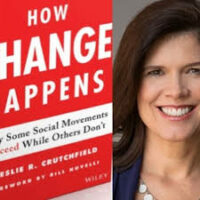
Tempered Radicals
Like most people I work with, I’m convinced that we need to catalyze a movement or movement that demands changes in the way we deal with conflict. As someone who has been involved in social and political movements for fifty years, I thought I understood what that involved. However, after reading books about social movements by authors who work in business schools and focus on the corporate world my thinking on what such a movement would have to look like has changed.
In addition to taking to the streets and issuing demands, it also makes sense to build movements that forge a series of incremental changes by working within existing institutions and concentrate on changing cultural norms as well as new public policies. I’m particularly drawn to the way Debra Meyerson refers to these activists as tempered radicals.
What Are Tempered Radicals?
On p. 2 of Rocking the Boat, she defines them as individuals who “engage in small local battles than wage dramatic wars” and goes on describe one of them who
Though her agenda for change is bold—she wants nothing less than to make the workplace more just and humane—her method of change is modest and incremental. Martha constantly negotiates the path between her desire to succeed within the system and her commitment to challenge and change it.
Meyerson, Leslie Crutchfield, and others who write about these kinds of change agents share the commitment of the individuals they discuss in their books. What we need to focus on is how they have (perhaps inadvertently) echoed the idea of making a “long march through the institutions” that was first made by the German student leader, Rudi Dutschke, in the late 1960s. Many of us who actually remember Dutschke, ended up having to follow his advice when we realized that we had to build careers. Those of us who found ways of combining a career with a long term commitment to far reaching social change often found ourselves teetering on what she calls a fault line between our desire to enhance our careers and to make a difference.
As I discovered most recently at my fiftieth college reunion, plenty of my friends who admired the likes of Rudi Dutschke when we were students found ways of becoming tempered radicals. And some of us have ended up making quite a difference in the microcosms of the communities we live and work in, if not on the national stage.
Acknowledging the importance of this approach to change is also a bit embarrassing in at least two ways. First, the ideas aren’t new. The first edition of Meyerson’s book came out almost twenty years ago. Second and more importantly, while I never fully acknowledged it until now, my own activist life has taken on tempered radical tones over the last least thirty years.
And Less Tempered Radicals?
Perhaps because I am a product of the 1960s politically and academically, I’ve thought of political and social movements from the perspective of what Charles Tilly—one of my mentors and friends—called contending politics. For the thirty years we knew each other, we argued back and forth about the role of nonviolence. I was convinced that you could get radical change using nonviolent tactics; reluctantly, Chuck was not convinced I was right.
The one thing neither Chuck nor I questioned was that social movements demanding dramatic change had to act from a position outside the political system and had to take strong oppositional stances before they could have an impact.
 Where do we go from here?
Where do we go from here?
Despite my debt to and friendship with Chuck, I adopted a different mindset about social change. No later than the time I started working with the Beyond War movement in the 1980s, I came to see that radical change can occur as a result of activism that starts in the mainstream of society and builds outward and upward.
I still agree with Chuck that there are times when we have to say “no.” Were he alive today, he would no doubt argue that we are living in one right now.
However, even at times like these, it is just as important to build movements that start in the social and economic mainstream and build outward and upward from there. That involves figuring out how you can make achieve and then build on what Meyerson calls small wins. For most of my friends that means working with their new peer group—their fellow retirees, many of whom have time and energy to spare. For those of us who are still working, new avenues include working with young peacebuilders, something I now find myself doing with a group of high school students.
In conclusion, one thing is clear. In the peacebuilding field, we have spent a lot of time worrying about how we should related to groups that engage in disruptive protests. Those have been wonderful and enlightening discussions.
Now, it also makes sense for us to focus, too, on how we deal with the likes of Meyerson and Crutchfield who draw our attention to the opportunities that come not only from working inside the system but embracing it.
The views and opinions expressed in this article are those of the author and do not necessarily reflect the official policy or position of the Alliance for Peacebuilding or its members.
